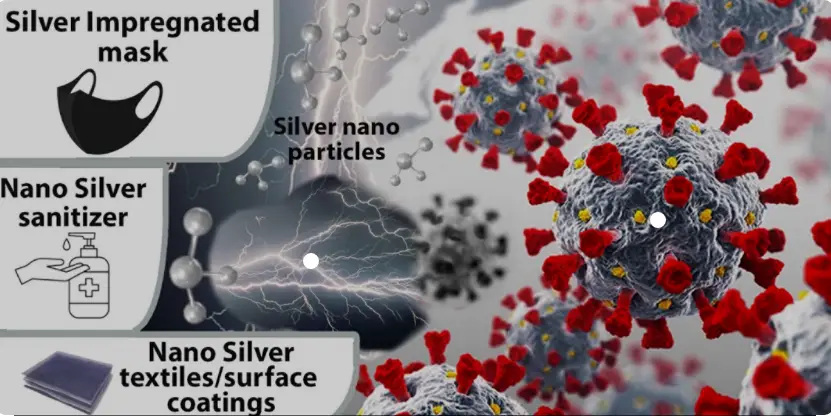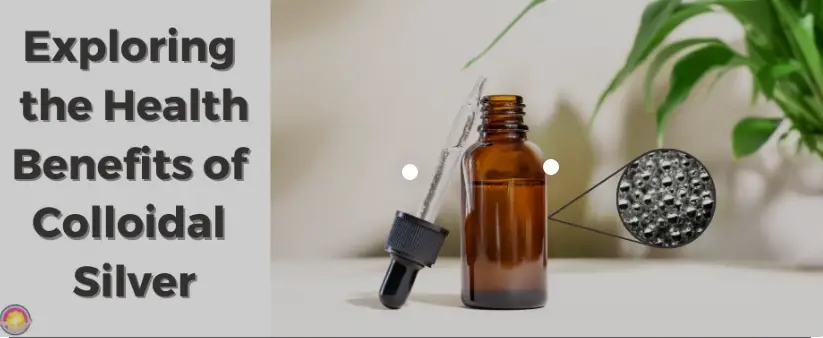Silver has long been recognized for its antimicrobial properties, making it a valuable element in various health and consumer products. Its utility extends beyond simple jewelry or currency; it’s a crucial component in many medical and technological applications. However, not all silver solutions are created equal. The terms “nano silver” and “colloidal silver” often come up in discussions about silver-based products, but they refer to distinct types with different characteristics and uses.
Nano silver and colloidal silver are both comprised of silver particles suspended in a liquid, but their particle sizes and manufacturing processes differ significantly, which affects their biological activity and applications. Nano silver typically has a particle size of less than 100 nanometers and is noted for its enhanced antibacterial efficacy. In contrast, colloidal silver particles are larger and the product has been used for health purposes for a longer time.
While both types of silver are used to prevent and fight infections, their effectiveness and safety profiles vary. Nano silver’s smaller particle size allows for greater surface area contact, making it more effective against bacteria at lower concentrations. Colloidal silver has been a popular alternative health treatment for decades, though its larger particle size and different ionic state can influence its utility and safety.

Defining Nano Silver
What is Nano Silver?
Nano silver refers to silver particles that are engineered to an ultra-small scale, typically less than 100 nanometers in size. At this microscopic level, silver exhibits properties that are not observable in its bulk form. This includes a significantly increased surface area relative to volume, which enhances its interaction with its environment, particularly in antibacterial applications.
Key Properties
The key properties of nano silver are predominantly defined by its size. These include:
- High Surface Area: The tiny particles provide a vast surface area compared to their mass, facilitating more extensive contact with microbes.
- Increased Reactivity: Smaller silver particles show greater chemical and biological reactivity, which is beneficial in applications like disinfection and sterilization.
- Optical Characteristics: Nano silver can absorb and scatter light, making it useful in certain imaging and diagnostic applications.
Common Uses
Nano silver is utilized in a variety of settings, reflecting its versatile antimicrobial and conductive properties. Some of the common uses include:
- Medical Devices: Coatings for catheters and other medical instruments to prevent bacterial infections.
- Textiles: Embedded in fabrics to create antimicrobial clothing and linens.
- Water Treatment: Used in filters to purify drinking water without the use of chemicals.
Defining Colloidal Silver
What is Colloidal Silver?
Colloidal silver is a suspension of silver particles, typically ranging from 10 to 1000 nanometers, in a liquid base. This form of silver has been used for centuries for its purported health benefits, although its use has been more controversial due to varying particle sizes and concentrations.
Key Properties
The properties of colloidal silver are influenced by the size and stability of the silver particles suspended in liquid. These properties include:
- Variable Particle Size: Ranging broadly impacts how the body absorbs and reacts to it.
- Ionic Silver Presence: Often contains a mix of silver ions and particles, which affects its antimicrobial potency and risk profile.
- Light Sensitivity: Colloidal silver can degrade or clump when exposed to light, altering its effectiveness and safety.
Common Uses
Despite debates over its efficacy and safety, colloidal silver is used in several applications, including:
- Dietary Supplements: Promoted for immune support and disease prevention.
- Topical Applications: Used in creams and ointments to treat minor cuts, burns, and skin infections.
- Alternative Medicine: Used by those seeking natural treatments for a variety of ailments.
Production Methods
How Nano Silver is Made
The production of nano silver typically involves complex technological processes that control the size and shape of the particles precisely. Common methods include:
- Silver Salt Reduction: Silver salts like silver nitrate are reduced in the presence of a reducing agent, which controls the growth of silver particles.
- Physical Vapor Deposition: Silver is vaporized in a vacuum and condensed onto a cool surface, forming fine particles.
How Colloidal Silver is Made
Colloidal silver is generally produced using simpler methods, which can vary in sophistication:
- Electrolysis: A common home production method where silver electrodes are submerged in water and voltage is applied, causing silver ions to disperse into the water.
- Silver Salt Reduction: Similar to nano silver, but typically lacks the tight control over particle size.
Particle Size and Distribution
Size Range of Nano Silver
Nano silver particles are usually between 1 and 100 nanometers. The precise control of particle size during manufacturing is crucial as it dictates the surface area and reactivity of the silver particles.
Size Range of Colloidal Silver
Colloidal silver particles vary more widely in size, from about 10 nanometers up to a few micrometers. The lack of uniformity in particle size can lead to inconsistent effects and potential aggregation of particles.
Impact on Effectiveness
The effectiveness of silver in nano and colloidal forms is heavily influenced by their particle size:
- Nano Silver: Smaller particles have a higher efficacy due to greater surface area per unit mass, enhancing their antimicrobial properties.
- Colloidal Silver: Larger and less uniform particles may result in reduced and less predictable antimicrobial activity.

Mechanism of Action
How Nano Silver Works
Nano silver acts primarily through its interaction with bacterial cell membranes. It is believed to attach to and penetrate these membranes, causing structural changes that lead to cell death. This action is facilitated by the release of silver ions (Ag+), which are highly reactive and can disrupt critical cellular processes, including:
- DNA Replication: Silver ions can bind to DNA, preventing the bacteria from replicating.
- Respiratory Enzymes: These ions can also inhibit key enzymes in the bacterial respiratory chain, leading to reduced cellular energy production and eventual cell death.
How Colloidal Silver Works
Colloidal silver works similarly by releasing silver ions when in contact with moisture. These ions then interact with bacterial cells leading to multiple effects:
- Membrane Damage: Like nano silver, colloidal silver can disrupt the cell membrane integrity.
- Protein Function Disruption: Silver ions can bind to bacterial proteins, rendering them nonfunctional, which impedes various cellular functions.
Efficacy and Applications
Comparative Efficacy
While both nano silver and colloidal silver are effective against a broad spectrum of bacteria, fungi, and viruses, nano silver is generally considered more potent. This is due to its smaller particle size, which allows for a higher surface area to interact with microbes, making it more efficient in lower concentrations.
Health and Medical Applications
Silver’s antimicrobial properties make it invaluable in health care. Nano silver is particularly useful in:
- Wound Dressings: It is incorporated into dressings to reduce infections in burns and other open wounds.
- Medical Devices: Coating various devices like stents and endotracheal tubes to prevent biofilm formation.
Colloidal silver is often marketed for internal use, although it lacks medical endorsement:
- Alternative Treatments: Used by some as a dietary supplement for its supposed immune-boosting effects.
Consumer Products
Both forms of silver are found in consumer products:
- Nano Silver: In appliances like refrigerators and air conditioners to prevent microbial growth.
- Colloidal Silver: In skin care products and some homeopathic remedies.
Safety and Regulation
Nano Silver Safety Profile
Nano silver is generally regarded as safe when used appropriately in commercial and medical products. However, concerns exist about its potential for causing silver buildup in the body and the environment. Studies are ongoing to assess its long-term effects.
Colloidal Silver Safety Profile
The safety of colloidal silver is more controversial, mainly due to cases of argyria, a condition caused by excessive silver intake leading to blue or gray skin staining. It is also not generally recognized as safe or effective by major health authorities like the FDA.
Regulatory Status
Regulations vary by country but typically involve:
- Product Labeling: Clear indications of silver content and intended use.
- Medical Device Coatings: Specific guidelines for devices intended for internal or prolonged skin contact.
Advantages and Limitations
Benefits of Nano Silver
- Effective at Lower Doses: Minimizes the risk of toxicity.
- Broad-Spectrum Antimicrobial: Effective against a wide range of pathogens.
Benefits of Colloidal Silver
- Long History of Use: Used for centuries as a natural antimicrobial.
- Accessibility: Easily purchased without prescription.
Limitations and Concerns
- Resistance Potential: Overuse might lead to resistance in microorganisms.
- Environmental Impact: Concerns about the accumulation and long-term environmental effects.
Future Trends
Research Directions
Current research is exploring:
- Enhanced Delivery Mechanisms: To improve the efficacy and reduce side effects of silver.
- Combination Therapies: Using silver with antibiotics to combat resistance.
Potential Innovations
Future innovations may include:
- Nano Silver-Enhanced Filtration Systems: For more efficient water and air purification.
- Advanced Biomedical Applications: Such as more effective antimicrobial implants and prosthetics.
Frequently Asked Questions
What is Nano Silver?
Nano silver consists of silver particles that are typically less than 100 nanometers in size. Due to its extremely small size, nano silver offers high surface area to volume ratio, which enhances its interactions with bacteria and viruses, making it an effective antimicrobial agent.
What is Colloidal Silver?
Colloidal silver is a suspension of silver particles in a liquid, where the particles are larger than those found in nano silver, generally ranging from about 10 to 1000 nanometers. It has been used historically as a natural antibiotic and for preserving drinking water.
How Are Nano Silver and Colloidal Silver Different?
The primary difference between nano silver and colloidal silver lies in their particle size and the concentration of silver. Nano silver has much smaller particles, resulting in a higher surface area that provides greater antimicrobial activity. Colloidal silver, with its larger particles, tends to be less effective at lower concentrations.
Which is Safer: Nano Silver or Colloidal Silver?
Nano silver is generally considered to be safer in controlled amounts due to its effective use at lower concentrations, reducing the risk of silver accumulation in the body. Colloidal silver, however, has been associated with more risks, particularly argyria, a condition that causes skin and other body tissues to turn blue-gray.
Can Nano Silver Replace Antibiotics?
While nano silver shows promising antibacterial properties, it is not a complete substitute for antibiotics. It is primarily used as a supplement to traditional antibiotic treatments, particularly in environments where bacteria may show resistance to conventional medications.
Conclusion
In conclusion, nano silver and colloidal silver serve critical roles in the realm of antimicrobial applications, each possessing unique properties and efficacies. Nano silver, with its smaller particle size, offers a more potent antibacterial action, making it suitable for use in a range of medical and consumer products. On the other hand, colloidal silver has a well-established history of use, though it carries potential risks if not used appropriately.
Understanding these differences is crucial for anyone considering the use of silver-based products for health or commercial purposes. Recognizing the distinct characteristics of nano and colloidal silver can help consumers make informed decisions about their use in everyday life and in various technological and health-related applications.

